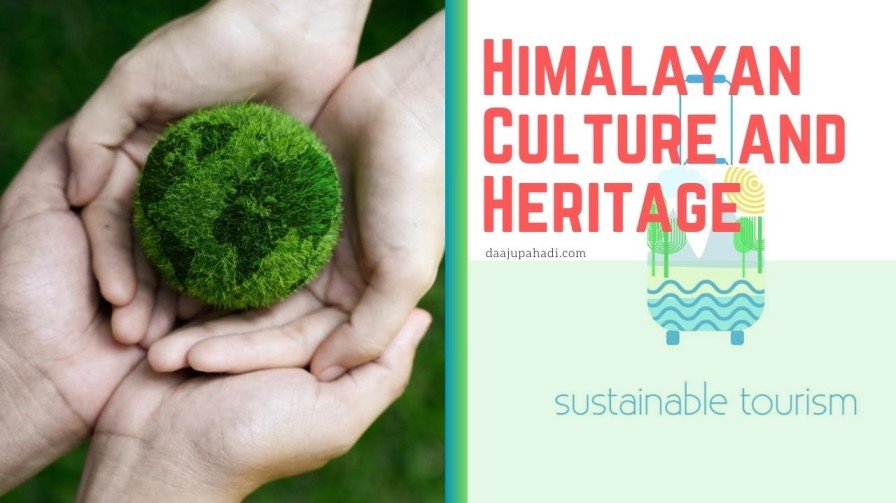
Introduction
Living in the mountains is not easy, but it is also rewarding. The mountain people of Uttarakhand have a rich and unique Himalayan culture and heritage that reflects their history, identity, values, beliefs, and practices. They also have a deep respect and understanding of nature and have developed various ways of managing their natural resources wisely and efficiently. In this blog post, we will explore how pahadi life or mountain life is a sustainable way of living, by looking at some examples of how the people of Uttarakhand use their natural resources, preserve their culture and heritage, and contribute to global sustainability goals.
How the People of Uttarakhand Use Their Natural Resources
One of the key aspects of sustainable living is to use natural resources wisely and efficiently, without depleting or degrading them for future generations. The people of Uttarakhand have developed various techniques and practices to do so, such as:
Contour farming
This is a method of ploughing the mountain slopes into terraces or steps, which helps to prevent soil erosion, conserve water, and increase crop yield. The people of Uttarakhand practise contour farming widely in the Kumaon and Garhwal regions.
Rainwater harvesting
This is a technique of collecting and storing rainwater for domestic or agricultural use, which helps to reduce dependence on external water sources, especially in areas with low rainfall or high water scarcity. Rainwater harvesting is practised in many parts of Uttarakhand, such as the Bageshwar district, where it has improved the water availability and quality for the local people.
Renewable energy
This is a form of energy that comes from natural sources that are replenished constantly, such as solar, wind, hydro, and biomass. Renewable energy is used in many parts of Uttarakhand, such as the Chamoli district, where it has provided clean and reliable electricity to remote villages that were previously off-grid.
How the People of Uttarakhand Preserve Their Culture and Heritage
Another important aspect of sustainable living is to respect and celebrate the diversity of cultures and traditions that enrich our world. The people of Uttarakhand have a rich and unique culture and heritage that reflects their history, identity, values, beliefs, and practices. Some examples of how the people of Uttarakhand preserve their culture and heritage are:
Folk arts
The people of Uttarakhand have a vibrant and diverse range of folk arts, such as dance, music, theatre, painting, carving, weaving, pottery, and embroidery. These folk arts express their emotions, stories, values, and beliefs, and also serve as a means of entertainment, education, and social cohesion. Some examples of folk arts from Uttarakhand are Aipan (a decorative art form using geometric patterns), Pichhaura (a traditional attire with motifs of gods and goddesses), Chholiya (a sword dance performed during weddings), and Jagar (a ritualistic folk song invoking the spirits of ancestors and deities)
Festivals
The people of Uttarakhand celebrate various festivals throughout the year, which mark important occasions such as religious events, seasonal changes, harvests, and anniversaries. These festivals are a way of honouring their ancestors, deities, and nature and expressing their gratitude, joy, and hope. Some examples of festivals from Uttarakhand are Harela (a celebration of greenery and prosperity), Nanda Devi Raj Jat (a pilgrimage to honour the goddess Nanda Devi), Basant Panchami (a festival of spring and education), and Makar Sankranti (a celebration of harvest and kite flying).
Languages
Many different languages, some of which are endangered or have no written form, are spoken by the people of Uttarakhand. These languages are a part of their identity and heritage and also carry valuable knowledge and wisdom about their environment and culture. Some examples of languages from Uttarakhand are Kumaoni, Garhwali, Jaunsari, and Bhoti, which belong to the Pahari group of languages. These languages have a rich oral tradition and literature and also reflect the influence of Sanskrit, Hindi, Tibetan, and Nepali languages.
How the People of Uttarakhand Contribute to Global Sustainability Goals
The final aspect of sustainable living is to recognize that we are all interconnected and interdependent and that our actions impact the global community and the planet. The people of Uttarakhand play a vital role in contributing to global sustainability goals, such as:
Climate action
The people of Uttarakhand are among the most vulnerable to the effects of climate change, such as melting glaciers, rising temperatures, extreme weather events, and loss of biodiversity. However, they are also among the most resilient and innovative in adapting to these changes, by adopting low-carbon lifestyles, using renewable energy sources, practising disaster risk reduction, and enhancing their adaptive capacity.
Biodiversity conservation
The people of Uttarakhand are custodians of some of the most diverse and threatened ecosystems in the world, such as forests, grasslands, wetlands, and alpine zones. They have a deep respect and understanding of nature and have developed various ways of protecting and managing their natural resources, such as community-based conservation, sacred groves, indigenous knowledge systems, and traditional ecological practices.
Poverty alleviation
The people of Uttarakhand face many challenges related to poverty, such as a lack of access to basic services, education, health care, markets, and opportunities. However, they also have many assets and potentials that can help them overcome these challenges, such as their natural resources, cultural diversity, social capital, entrepreneurial spirit, and tourism potential.
Know more about Sustainable tourism Here
Conclusion
Pahadi life or mountain life is a sustainable way of living that can inspire us to live in harmony with nature and each other. The people of Uttarakhand have shown us how to use their natural resources wisely and efficiently, preserve their culture and heritage with pride and dignity, and contribute to global sustainability goals with resilience and innovation. By learning from their example, we can also adopt a more sustainable lifestyle that benefits ourselves and the planet.